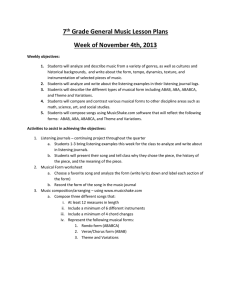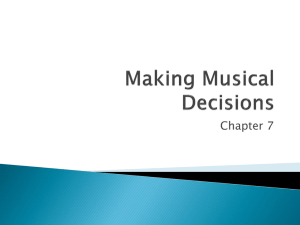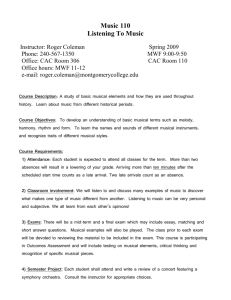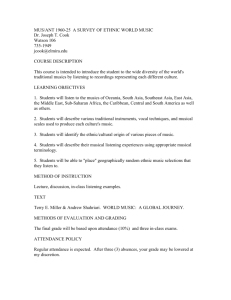Sgt. Pepper's Lonely Hearts Club Band
advertisement
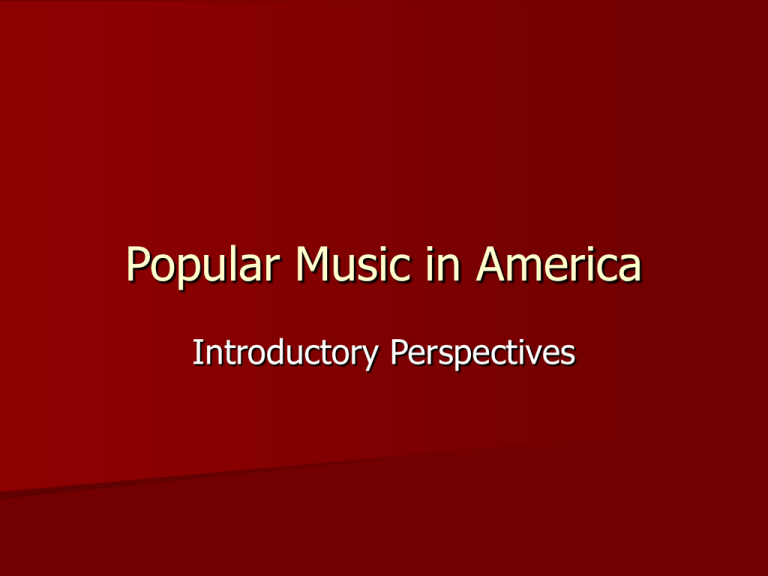
Popular Music in America Introductory Perspectives Goals Think creatively and critically about popular music Listen to popular music and learn something about its history and the people and institutions behind it Cover a wide range of music from nineteenth century to the turn of the 21st century Popular Music—Definitions Music created with commercial success in mind Popularity measured in numbers—how many albums sold, how many Number One hits Can be compared with other styles that differ in intent as well as musical result – Popular – Classical – Folk This definition is problematic because some music crosses the boundaries of genre. “Garage bands,” which are similar to folk music Piano rags by Scott Joplin: “art” or “popular” music? The Beatles’ album Sgt. Pepper’s Lonely Hearts Club Band Popular Music—Definitions In broad terms, popular music can be used to indicate – music that is mass-produced and disseminated via the mass media, – at various times has been listened to by large numbers of Americans, and – typically draws on a variety of preexisting musical traditions. Theme One: Listening Critical listening – Listening that consciously seeks out meaning in music How music is put together Its cultural significance Its historical development Even nonmusicians have much more knowledge about music than they may realize: – – – – A chord that sounds “wrong” A note that is “out of tune” Or a singer who is “off key” Theme One: Listening In everyday life, people often do not think carefully about the music they hear. Much popular music is designed not to call critical attention to itself. Other types of popular music—big band swing, funk, punk rock, hard rap, thrash metal—seek to grab attention but do not, by and large, encourage close analysis. Theme One: Listening The point of analyzing popular music is not to ruin your enjoyment of it. – You are encouraged to expand your tastes, hear the roots of today’s music in earlier styles, and be a more critically aware “consumer” of popular music. Theme One: Listening Formal analysis – The musical structure of the music Much popular music draws on a limited number of basic formal structures. – Twelve-bar blues – AABA melodic structure Musical Process How is a song interpreted? Listening and studying popular music is not simply analyzing a song but also studying interpretations by particular performers. Terms Specific to Popular Music and This Course Riff—repeated pattern designed to generate rhythmic momentum Hook—catchy musical phrase or riff Groove—channeled flow of “swinging” or “funky” or “phat” rhythms Terms Specific to Popular Music and This Course Timbre—characteristic sound of an instrument or voice – Sometimes called “tone color” – Plays an important role in establishing the “soundprint” of a performer Lyrics—The Words of a Song In many cases, words are designed to be one of the most immediately accessible parts of a song. In other cases, the lyrics seem to demand interpretation. Dialect – Some musical genres are strongly associated with particular dialects. Theme Two: Music and Identity We use popular music to find and express our identity Popular music is closely tied to stereotypes. People value music for many reasons To understand the cultural significance of popular music, we must examine – the music—its tones and textures, rhythms and forms—and – the broader patterns of social identity that have shaped Americans’ tastes and values. Theme Three: Music and Technology Technology has shaped popular music and has helped disseminate it. Older technologies often take on important value as tokens of an earlier, often claimed better, time. People frequently seek to exert creative control over the role of musical machines in their own lives. Theme Four: The Music Business The production of popular music typically involves the work of many individuals performing different roles. Sheet music – From the nineteenth century until the 1920s, it was the principal means of disseminating popular songs The music business relies on predicting popular musical tastes and trends. Relationship between “majors” and “indies” Theme Five: Centers and Peripheries Center-periphery model – – “Center”—several geographically distinct centers where power, capital, and control over mass media are concentrated “Periphery”—smaller institutions and people historically excluded from the political and economic mainstream
